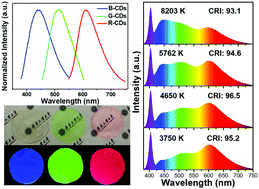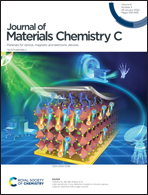Bright tricolor ultrabroad-band emission carbon dots for white light-emitting diodes with a 96.5 high color rendering index†
Abstract
Fluorescent carbon dots (CDs) have emerged as promising materials for white light-emitting diodes (WLEDs) on account of carbon's intrinsic merits of high stability, low cost, and environment-friendliness. However, CDs usually give relatively narrow emission with full width at half maximum within 70–90 nm, which fundamentally restrains construction of CDs-based WLEDs with high color rendering index (CRI). Here, we demonstrate tricolor ultrabroad-band (109–120 nm) emissive CDs (Tri-CDs) with a quantum yield (QY) up to 21–64% by a one-pot solvothermal route. Experimental investigations reveal that tunable emissions of these CDs are based on differently sized sp2 conjugated domains and the content of graphitic nitrogen, which can be modulated by controlling the carbonization and deamination processes during solvothermal reactions. The ultrabroad-band emission spectra of Tri-CDs originate from broad distribution of the particle size. A WLED with Commission Internationale de l’Eclairage (CIE) color coordinate of (0.362, 0.370) and high CRI of 96.5 is fabricated by integrating Tri-CDs films with an ultraviolet LED chip. This work opens up a new opportunity for the development of high CRI CDs-based WLEDs.



 Please wait while we load your content...
Please wait while we load your content...